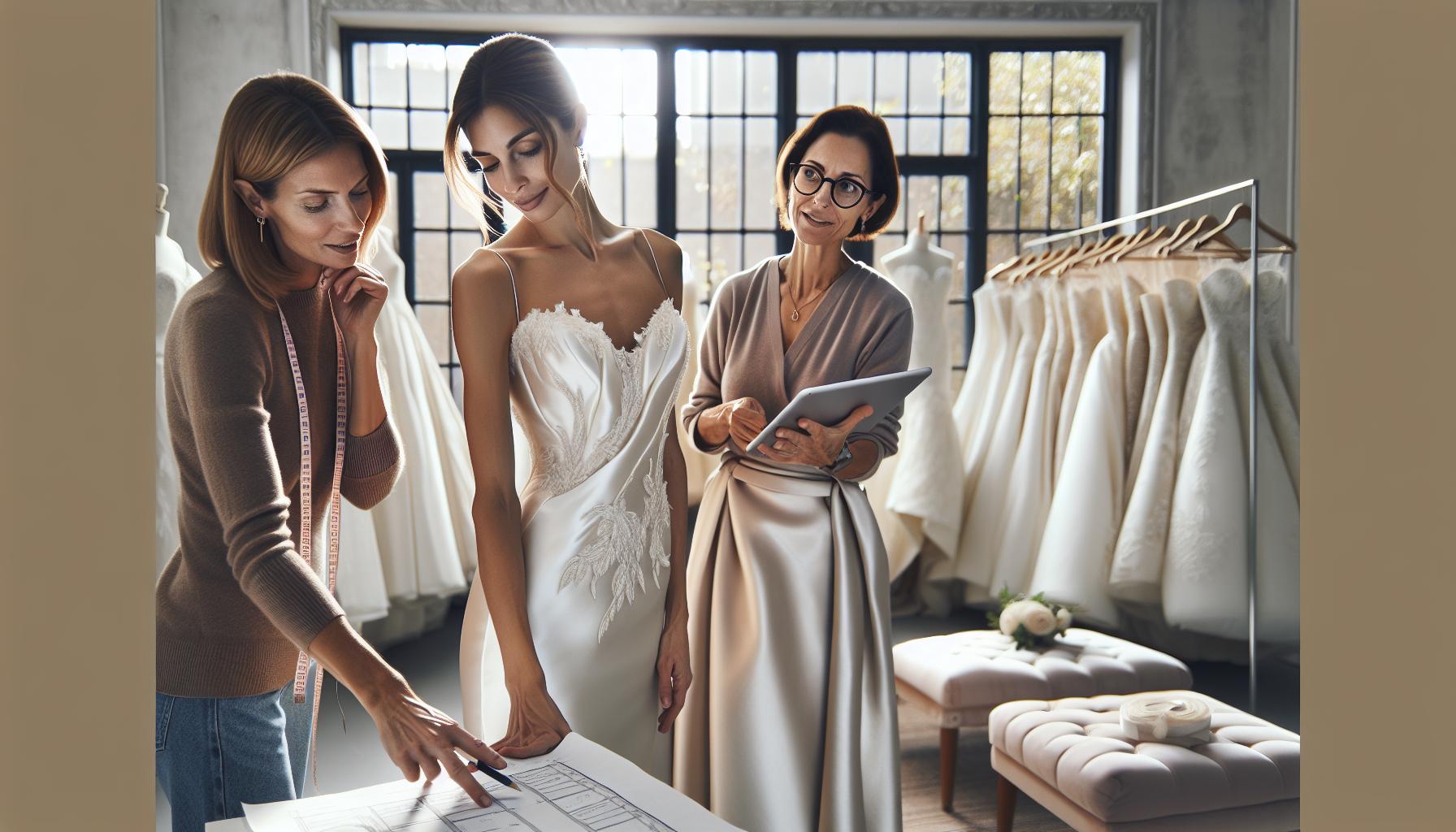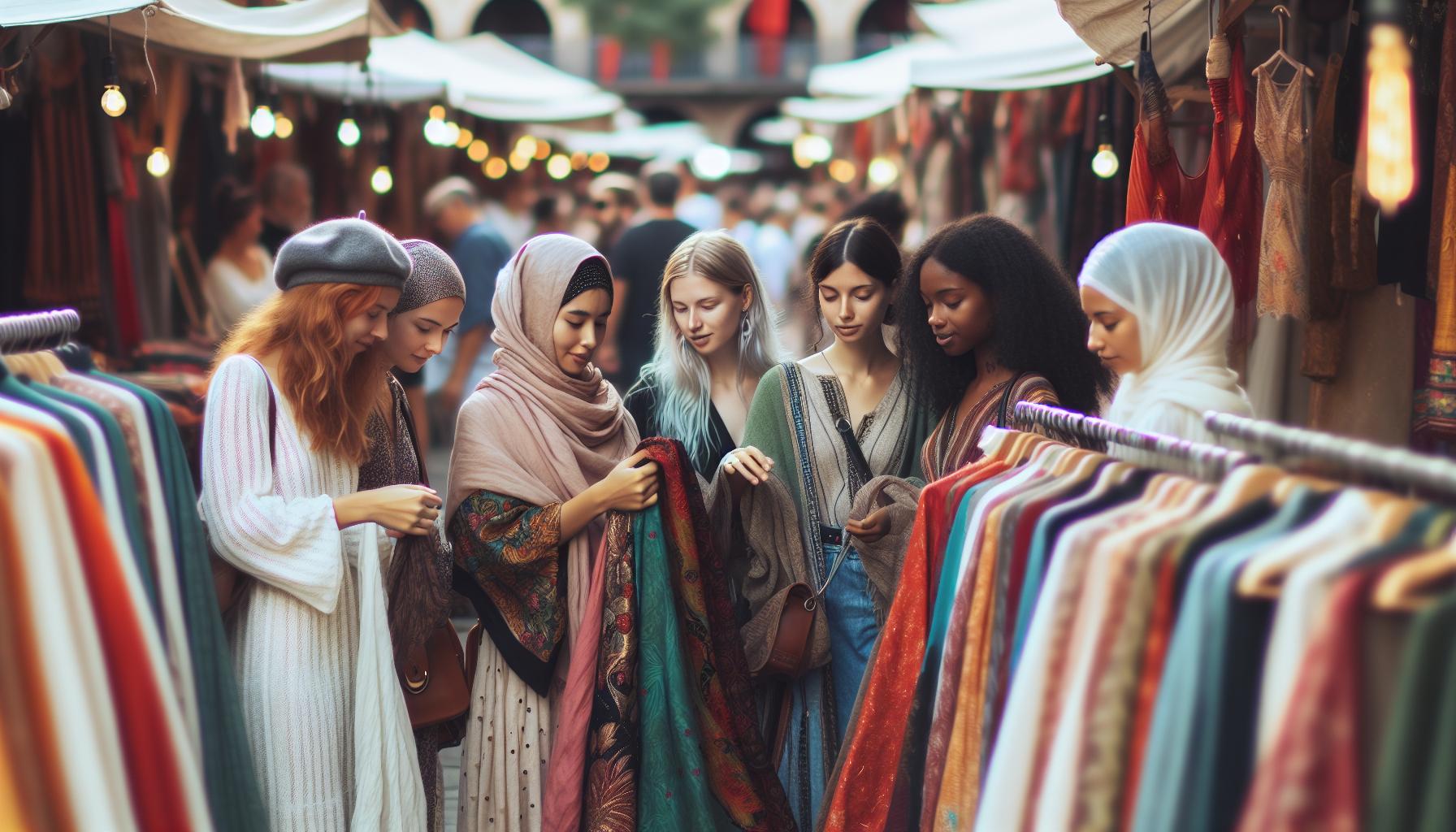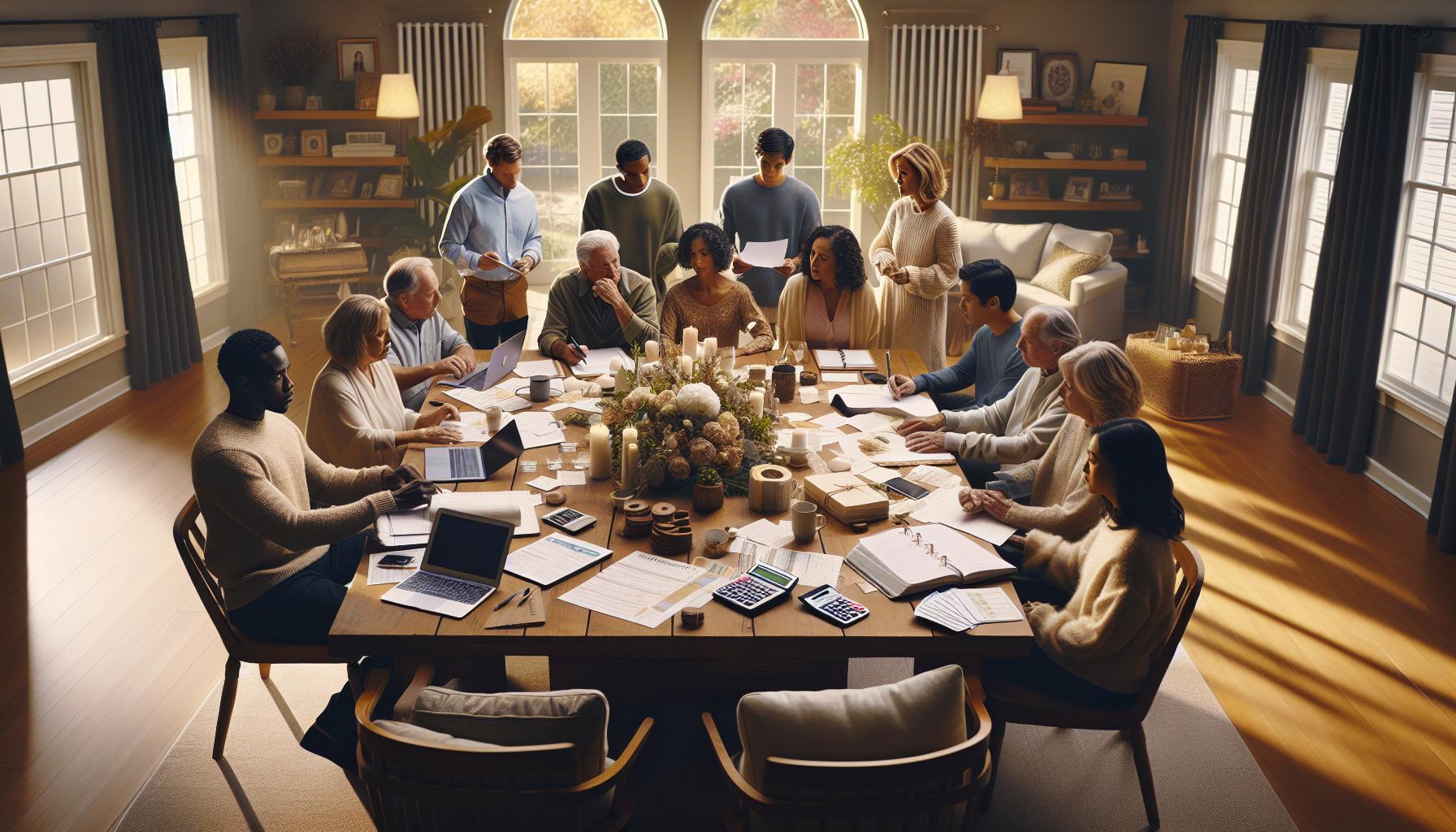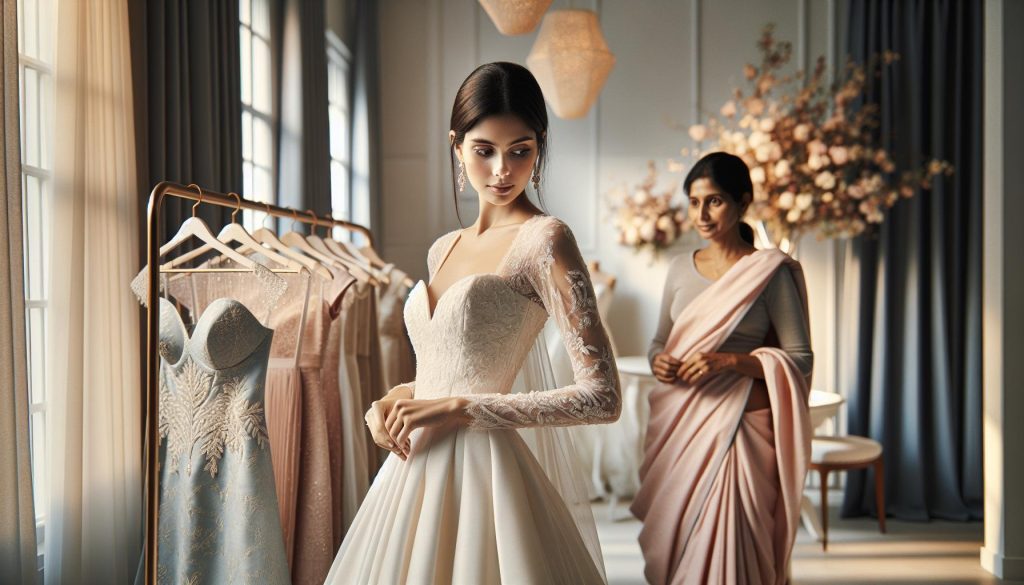Navigating the world of wedding expenses can feel overwhelming, especially when it comes to one of the most iconic pieces of the celebration: the bride’s dress. Traditionally, this beautiful garment symbolizes the beginning of a new chapter, but questions often arise about who is responsible for purchasing it. Understanding this aspect of wedding etiquette not only clarifies expectations but can also ease financial planning for couples and their families. As you dive into this guide, you’ll uncover the various customs surrounding dress purchases, enabling you to make informed decisions that honor your unique circumstances. With creativity and communication, the journey to finding the perfect dress can become a joyous part of your wedding planning adventure.
Who Typically Pays for the Bride’s Dress?
The moment a bride envisions her wedding day, the wedding dress often becomes a symbol of love and commitment, a dream piece that encapsulates her personal style. Traditionally, the responsibility for purchasing the bride’s dress has leaned heavily toward the bride’s parents, continuing to reflect the age-old customs surrounding weddings. However, this practice has evolved significantly, with many modern couples choosing to share the costs or shifting the financial burden entirely onto the bride or her fiancé, depending on their unique situations and cultural backgrounds.
In today’s diverse landscape of wedding planning, there is no rigid rule dictating who should pay for the bride’s dress. Factors such as family dynamics, financial situations, and personal preferences play pivotal roles. For instance, in some families, it is customary for the bride’s parents to cover the dress, while in others, the brides themselves or their future partners make this purchase. Couples may also decide to pool resources or receive contributions from both sets of parents, reflecting a more collaborative approach to wedding expenses.
It’s essential for couples to open a dialogue about expectations and budgets as they begin planning their wedding attire. This conversation can alleviate misunderstandings and ensure that all parties feel included in the planning process. Regardless of who ultimately pays, it’s important to prioritize the bride’s vision for her dress, staying within a budget that feels manageable while celebrating the joyous occasion ahead. By being transparent about costs and preferences, couples can embark on their wedding journey with confidence and excitement.
Understanding Wedding Dress Costs
The journey of choosing a wedding dress is often filled with excitement, inspiration, and a touch of anxiety, especially when it comes to understanding the associated costs. In the world of bridal fashion, prices can vary dramatically, depending on the designer, materials, and intricacies involved in the garment’s creation. A bride may find herself wandering through boutiques, enchanted by stunning gowns, only to discover that reality may differ from her expectations when she flips the price tag.
To help navigate these expenses, it’s valuable to consider key factors that influence wedding dress costs, including:
- Designer & Brand: Gowns from renowned designers typically carry a premium price. Consider if brand prestige is worth the investment for you.
- Materials & Fabrics: Silks, lace, and embellishments contribute significantly to the dress’s overall price. Each material brings its own charm but also varies in cost.
- Complexity of Design: Intricate designs, such as detailed beading or unique patterns, often come with higher price points due to the labor involved in their creation.
- Location: The geographical area of the bridal shop can also impact pricing, with urban boutiques frequently charging more than those in smaller towns.
- Customization: Custom-made gowns are an attractive option for many brides, but they may require a larger budget due to the tailored fit and individual specifications.
Understanding what contributes to the costs can empower brides to make informed decisions when budgeting for their wedding attire. It’s important to remember that a wedding dress symbolizes more than just fashion; it embodies the love story and the beginning of a new chapter. By setting a realistic budget and exploring various options, brides can find their dream dress without financial regret. Engaging in open discussions with family members who may contribute to the purchase can also streamline this process, blending individual preferences with financial realities.
Ultimately, the perfect dress is worth every ounce of effort and collaboration. With careful planning, a sense of adventure, and a sprinkle of creativity, brides can enjoy this significant part of their wedding journey, emerging with a gown that reflects their unique style and the joy of their special day.
Cultural Influences on Dress Buying Traditions
The traditions surrounding who pays for the bride’s dress can vary widely around the globe, shaped by cultural norms, family roles, and personal values. In many Western cultures, it has become customary for the bride and her family to bear the costs of her wedding attire. This practice symbolizes the bride’s parents’ investment in her journey to start a new life with her partner, reflecting a traditional view of familial responsibility. However, as modern values evolve, so too do these customs, leading to increasingly diverse interpretations of this age-old practice.
In contrast, various cultures bring unique perspectives to wedding attire financing. For instance, in some Asian traditions, the groom’s family may play a more significant role in financial matters, including the bride’s dress. In Chinese weddings, families often collaborate to manage costs, symbolizing unity and mutual respect between the two families. Similarly, in Indian cultures, extravagant bridal dresses, often richly adorned with intricate embroidery and gemstones, may be paid for entirely by the groom’s family, emphasizing the importance of the bride’s beauty and status during the wedding celebration.
Moreover, many couples today are seeking to redefine these conventions, opting for more egalitarian approaches to wedding costs. The practice of crowdfunding or sharing expenses between the bride and groom’s families reflects contemporary values of partnership and shared responsibility. Couples may discuss their preferences early on to find financial arrangements that resonate with both families while honoring personal traditions and sentiments.
As you navigate the landscape of wedding attire, remember that open communication is essential. Discussing who will cover the costs can ease potential tensions and align expectations, fostering a spirit of cooperation that enhances this beautiful milestone. Ultimately, whether rooted in tradition or arising from modern collaboration, the decision about purchasing the wedding dress can contribute to a profound sense of unity and celebration among families and couples alike.
The Role of Family in Wedding Expenses
Understanding the financial dynamics of wedding expenses can transform what might seem like a daunting task into an exciting collaborative journey. Families often play pivotal roles in this aspect of wedding planning, significantly influencing decisions about the bride’s dress and other related attire. Traditionally, it has been expected that the bride’s family covers the costs, symbolizing their support and investment in her new life. This honor often reflects deep familial bonds and cultural values intertwined with the wedding celebration itself.
In many cases, however, this financial responsibility is evolving with changing societal norms. Contemporary couples increasingly favor a more flexible approach where families can collaborate on expenses. This might mean sharing costs based on each family’s financial situations or splitting expenses in ways that promote equality and enhance familial unity. For instance, the bride’s parents might still cover her wedding dress, while the groom’s family takes on other significant expenses such as the venue or the rehearsal dinner. Open conversations about financial responsibilities allow families to share their expectations and reinforce the sense of partnership at the heart of this joyous occasion.
Moreover, family members often contribute more than just financial resources. Involvement in choosing the dress can turn into an unforgettable bonding experience. For example, a mother might accompany her daughter to various boutiques, offering her insights and support, making selections feel less like a shopping trip and more like a cherished rite of passage. This collaborative spirit not only lightens the financial load but also adds meaningful layers to the wedding process, as families forge deeper connections through shared experiences.
Ultimately, is not solely about who pays for what; it’s about weaving together individual stories, traditions, and values into a unified celebration of love. Embracing these discussions with openness and creativity will lead to a customized approach that respects both familial traditions and personal preferences, ensuring that every aspect of the wedding, including the bride’s dress, resonates with joy and familial love.
Budgeting for the Bride’s Dress: A Comprehensive Guide
Creating a budget for the bride’s dress can feel like navigating a lush garden of choices, each more beautiful than the last, but understanding how to manage these costs will ensure your wedding journey remains joyful and stress-free. To embark on this delightful excursion, it’s essential to first determine a realistic budget aligned with both your vision and financial situation. Start by discussing candidly with family members who might contribute, setting the stage for open communication throughout the planning process.
Assessing Dress Costs
Begin by gathering information on the average costs of wedding dresses in your preferred styles. You can categorize dresses into different tiers based on designers and quality, ranging from budget-friendly options to high-end couture. A typical wedding dress can range from a few hundred dollars to several thousand, depending on factors such as brand, fabric, and detail. Here are some practical steps to help you:
- Research: Spend time browsing bridal magazines and websites to discover styles you love and their price points.
- Set a Range: Determine your “ideal dress budget” and a maximum limit, giving yourself some flexibility.
Consider Additional Costs
Remember to factor in associated expenditures that might significantly impact the overall cost. These can include:
- Alterations: Most dresses will require tailoring to ensure a perfect fit. Alteration costs can vary widely, so it’s wise to ask your bridal shop for estimates.
- Accessories: Don’t forget about vital additions such as veils, shoes, or jewelry, which can enhance your look but require their own budgetary considerations.
- Preservation: Post-wedding dress preservation can also be an extra expense, so plan for it if you wish to cherish your dress for years to come.
Plotting a Fashionable Journey
Create a structured approach to your shopping excursions. Use the following tips for a seamless experience:
- Schedule Appointments: Book visits to a variety of boutiques and trunk shows to explore different designers and styles.
- Limit Your Entourage: While sharing this experience is magical, consider limiting the number of guests to avoid overwhelming yourself with opinions.
- Keep Track: Maintain a notebook or digital file to log your dress preferences, pricing, and any inspiration that ignites your vision.
Embrace the Adventure
Lastly, infuse excitement into this budget-building journey. Whenever possible, create a celebratory atmosphere by treating dress shopping like a special occasion. Whether it’s popping a bottle of bubbly with your closest friends or planning a fun outing afterward, remember that choosing your wedding attire should be an enjoyable chapter in your love story. By setting a budget that reflects your dreams while being mindful of your financial landscape, you’ll not only find “the one” but also feel empowered and prepared for the beautiful adventure that lies ahead.
Shopping for the Dress: Tips for Couples and Families
Shopping for the bride’s dress can be one of the most memorable experiences in wedding planning, brimming with joy, excitement, and a touch of glamour. Couples and families often embark on this journey together, and creating a supportive atmosphere enhances the experience. To make the most of this special occasion, it’s crucial to approach dress shopping with intention and enthusiasm.
When starting your shopping adventure, schedule appointments at various bridal boutiques and specialized stores. This not only allows for a wide range of styles but also keeps the experience fresh and exciting. Consider exploring local trunk shows or designer showcases, where you might discover exclusive gowns and unique options. It’s essential to limit your entourage to those whose opinions you trust. Too many voices can lead to confusion, so choose a few close friends or family members to join you-ideally, people who will offer constructive feedback rather than just opinions.
Another effective strategy is to keep a detailed record of your choices. As you visit different shops, take notes or photos of dresses that catch your eye. Create a digital or physical folder to organize your favorites alongside their price points and designers, allowing you to revisit your vision easily. Spending time in a comfortable and joyful environment fosters creativity, so treat this shopping journey as a celebration. Perhaps you could turn a dress fitting into a mini-day of fun, with lunch before or after and a toast to future memories.
As you dive into the sea of options, remember that communication within the group is key. Be open about your preferences and budget while still being receptive to suggestions. Engaging in this part of the wedding planning process as a team not only strengthens relationships but also ensures everyone feels included in the bride’s moment of magic. Keep the atmosphere light and celebratory, as this experience should reflect the joy and love surrounding your upcoming union. By following these practical tips, you’ll transform dress shopping into an enjoyable adventure filled with cherished memories and beautiful beginnings.
Breaking Down Dress Alteration Costs
The beautiful journey toward finding the perfect wedding dress often involves a crucial but sometimes overlooked aspect: alterations. Most brides discover that even a dream gown may require adjustments to ensure it fits flawlessly. Understanding the costs associated with dress alterations can help manage the overall budget and set realistic expectations for this essential part of the bridal experience.
Alteration costs can vary widely based on several factors, including the complexity of the changes needed, the fabric of the dress, and the seamstress’s experience. On average, brides should anticipate spending anywhere from $150 to $600 on alterations. Here’s a breakdown of common alterations and their associated costs:
- Hemming: Shortening or adjusting the length of a gown typically costs between $50 and $150, depending on the fabric and complexity.
- Taking in or letting out: Adjusting the fit around the bust, waist, or hips may range from $50 to $150 per area.
- Adding or removing sleeves: This can be more intricate and could cost between $75 and $200 based on design changes.
- Bustle: Creating a bustle (to gather the train for dancing) is usually about $60 to $150, depending on the gown’s complexity.
It’s recommended to consult with a bridal salon or an experienced seamstress early in the process to assess the necessary alterations. This proactive approach ensures you receive transparent pricing and can even provide recommendations tailored to your specific dress style. Moreover, getting a second opinion on the alterations can also be beneficial, as it promotes a sense of assurance and confidence in your choices.
Incorporating the cost of alterations into the overall wedding attire budget is crucial. This way, brides can allocate funds accordingly, ensuring they do not overlook this important element. In some cases, brides may even consider sharing alteration costs with family members who are contributing to the dress budget, promoting collaboration and shared joy during this poignant moment. After all, every bride deserves to feel perfectly radiant on her special day, and a well-fitted dress is integral to that experience.
Paying for Accessories: Who is Responsible?
The excitement of planning a wedding often extends beyond the dress itself, leading to the important question of accessories. From sparkling jewelry to elegant shoes and stunning veils, these details can add significant beauty to the bridal look. Understanding who is typically responsible for purchasing these accessories can help streamline wedding budgets and maintain clear communication between the couple and their families.
Traditionally, brides have been responsible for acquiring their accessories, aligning them with their personal style and wedding vision. This includes decisions about items like earrings, necklaces, and hairpieces that complement the wedding dress. However, modern couples often approach these expenses collaboratively, allowing both parties and their families to share this joy. For instance, a groom might choose to present his bride with a special piece of jewelry as a wedding gift, or parents may contribute to the overall accessory budget, promoting family involvement in the planning process.
When discussing accessories, it’s essential to consider the total cost and how it fits into the overall wedding budget. Brides should feel empowered to create a separate budget for accessories that reflects their preferences and allows room for flexibility. This could include deciding on must-have items versus optional ones, making it easier to prioritize spending.
Overall, regardless of who ultimately pays, open dialogue about accessory expectations and budgets can lead to a happier, more cohesive wedding planning experience. Couples can also encourage family members to express their desires in contributing, creating a shared narrative that enriches the celebration of love.
Alternative Funding Options for Wedding Attire
Exploring creative funding options for wedding attire can turn the dream of wearing the perfect dress into a reality without overwhelming your budget. Couples today increasingly seek innovative ways to finance their wedding essentials, including the beloved bridal gown, which often represents a significant expense. Engaging in discussions about finances may reveal unexpected sources of support and inspiration.
One fantastic alternative is collaborative funding through family and friends. Consider hosting a pre-wedding gathering, such as a bridal shower or a themed party where guests can contribute financially instead of bringing gifts. This shared experience not only cultivates a spirit of togetherness but also allows attendees to play an active role in your wedding journey. For those who may not have the funds available for a lavish gift, this approach provides a meaningful way to support your dream attire.
Online fundraising platforms can also serve as a practical avenue for sourcing financial contributions. Websites like GoFundMe or Honeyfund allow couples to create a personalized page explaining their wedding attire needs. Sharing this link with family and friends may yield surprising generosity, enabling supporters to contribute any amount they want, which could go directly toward the costs of the wedding dress and accessories.
Additionally, consider renting or buying pre-owned outfits, which can significantly reduce costs while still allowing you to look stunning on your special day. Websites and local bridal boutiques often offer rental services at a fraction of the purchase price. Meanwhile, platforms like Stillwhite or Tradesy allow brides to buy previously loved dresses at discounted rates, making it easier to manage expenses without sacrificing style.
Finally, don’t overlook loans from family or a modest personal loan as a way to finance your wedding attire. Discussing any potential support upfront can lead to agreements that respect the contributions while maintaining harmony among family members. Make sure to establish clear repayment terms if choosing this path, ensuring that it is a win-win situation for everyone involved.
As you navigate the beautiful journey of planning your wedding, keep an open mind towards these alternative funding options. They not only alleviate financial stress but also encourage a collaborative spirit that enhances the significance of your special day. Remember, it’s about cherishing your love story-whether through your attire or the deep connections with those who support you along the way.
Navigating Dress Fittings with Family Dynamics
Planning dress fittings can be a delightful yet sometimes complicated experience, particularly when family dynamics come into play. The process of selecting the perfect wedding dress is a sentimental journey, often involving hands-on input from various family members. To ensure that this special time is joyful and harmonious, consider fostering open communication and establishing clear expectations from the outset.
Involving family in dress fittings can create cherished memories, but it’s essential to navigate the range of opinions that might arise. To manage this, set the groundwork early by communicating your vision and preferences about who will be involved. Create a guest list for fittings that includes supportive family members whose opinions you value, allowing you to enjoy their company without overwhelming yourself with conflicting suggestions. This approach not only ensures that the experience remains positive but also honors your relationships with loved ones.
During fittings, remember to practice patience and diplomacy when facing contrasting opinions. Families often have different ideas shaped by their unique cultural backgrounds and personal experiences. Rather than dismissing feedback outright, try to incorporate suggestions thoughtfully. For instance, if an aunt insists on a particular style that doesn’t resonate, you can acknowledge her input while gently steering the conversation back to your choices. Phrasing your decisions with appreciation, such as “I love that idea, and here’s why I’m leaning toward this option…” helps maintain a collaborative spirit.
Finally, after the fittings, take a moment to express gratitude. Whether it’s with heartfelt thank-you notes or a post-fitting dinner, these tokens of appreciation reinforce the love and support that surrounds your wedding planning process. By fostering a nurturing environment and understanding that everyone means well, you transform fittings into a joyful celebration of family and love. In the end, remember that your wedding is a reflection of you and your partner’s journey, with family as precious alongside you on this beautiful adventure.
Today’s Trends: Who Pays for Wedding Attire?
With evolving cultural norms and financial landscapes, the question of who pays for wedding attire has taken on new dimensions. Traditionally, the bride’s family was expected to shoulder the costs of her dress, but modern couples are redefining these roles, often opting for a more collaborative approach. This shift reflects changing values, emphasizing partnership and shared responsibilities in wedding planning.
In today’s landscape, it’s not uncommon for the bride and groom to both contribute to the expense of the wedding attire. Many couples set a budget for the entire wedding, which includes dressing the bridal party. This approach allows for greater communication about financial expectations while ensuring that both partners feel valued and involved in the process. Additionally, couples are discovering alternative methods to cover these costs, such as crowdfunding from family or friends, or utilizing savings set aside specifically for wedding expenses.
Family traditions also play a significant role, with cultural influences shaping who pays for what. In some cultures, it remains customary for the bride’s family to cover the wedding attire, while in others, the groom’s family may take on this responsibility. There are even instances where both families collaborate, contributing to different aspects of the couple’s attire. Understanding and respecting these traditions can enhance the planning process and foster harmony among families.
Ultimately, today’s trends reflect an inclusive approach that celebrates the couple’s individuality and shared journey. Whether the dress is a family heirloom or a custom creation, it’s essential that the financing aligns with the couple’s vision for their wedding. Clear communication about expectations, budgets, and responsibilities will help couples navigate the intricacies of wedding attire expenses joyfully and gracefully.
Creating a Dress Budget: What to Consider
Creating a budget for the bridal dress can be one of the most exciting yet challenging aspects of wedding planning. As the cherished moment approaches, envisioning the perfect gown that reflects personal style and complements the wedding theme is a delightful task. However, grounding this vision in a realistic budget is essential to ensure that the dress enhances the joyful experience without causing financial stress.
Start by assessing the overall budget for the wedding. This holistic approach allows couples to allocate funds more effectively while prioritizing what they value most in their wedding attire. For instance, it helps to break down the budget into categories, such as the dress itself, alterations, accessories, and even shoes. Couples may find it helpful to create a simple table like this:
| Category | Estimated Cost |
|---|---|
| Wedding Dress | $1,500 |
| Alterations | $300 |
| Accessories (veil, jewelry, etc.) | $200 |
| Shoes | $100 |
| Total | $2,100 |
Once the categories and estimated costs are identified, exploring options within each section becomes more manageable. Research is key: visiting bridal shops, searching online boutiques, and even considering pre-owned or rental options can significantly broaden choices while keeping costs down. Many bridal shops offer sample sales or trunk shows, where brides can find gowns at reduced prices, providing a perfect opportunity to snag a dream dress without breaking the bank.
In addition to tangible expenses, it’s wise to factor in potential unexpected costs that could arise during the wedding journey. Think about things like shipping fees for online orders, additional accessories that may catch the eye during fittings, or last-minute alterations. Discussing these possibilities early on with family or partners can help reinforce the budget and promote transparency.
Finally, remain flexible. If a desired dress goes beyond the budget, it’s perfectly acceptable to consider similar styles or look at alternative designers. Many brides have discovered their perfect dress outside their initial vision, turning budget constraints into creative inspiration. Embrace the journey of finding the dress-each step is part of a joyful story leading to the cherished day, and a well-planned budget helps keep the experience delightful and stress-free.
Frequently Asked Questions
Q: Who traditionally pays for the bride’s dress?
A: Traditionally, the bride’s family is responsible for covering the cost of her wedding dress. This practice stems from historical customs where the bride’s family financed most of the wedding expenses. However, these norms can vary based on personal circumstances and cultural customs.
Q: What factors influence who pays for the bride’s dress?
A: Factors like family dynamics, cultural traditions, and financial capabilities significantly influence who pays for the bride’s dress. In modern weddings, couples often discuss and decide together who will cover the costs based on their unique situations and preferences.
Q: Can the bride pay for her own dress?
A: Yes, the bride can definitely pay for her own dress. Many modern couples prioritize financial independence and may choose to have the bride purchase her dress, particularly if she has specific preferences or budgets in mind.
Q: Are there alternatives for funding the bride’s dress?
A: Alternatives for funding the bride’s dress include setting up a wedding registry that allows guests to contribute, seeking family support, or using savings. Discussing financial responsibilities openly can also lead to creative solutions to afford the desired attire.
Q: How can couples budget for the bride’s dress?
A: Couples can budget for the bride’s dress by determining overall wedding costs and allocating a specific amount for attire based on their financial situation. Creating a detailed budget can help streamline the shopping process and avoid overspending.
Q: What should be considered when choosing a wedding dress?
A: When choosing a wedding dress, consider factors like style, fit, the venue, and budget. It’s essential to balance personal taste with practical considerations, such as comfort and the wedding theme.
Q: How can family dynamics affect dress shopping?
A: Family dynamics can play a significant role in dress shopping, influencing decisions around style, budget, and decision-making. Open communication and compromise can help ease tensions and ensure a more enjoyable dress shopping experience.
Q: What are some current trends in who pays for a wedding dress?
A: Current trends show a shift towards more egalitarian contributions where brides and grooms share costs or couples fund their attire together. Additionally, many families are exploring creative options for coverages, such as group contributions or collective family funds.
In Summary
As you navigate the exciting journey of wedding planning, understanding who typically buys the bride’s dress is just one piece of the puzzle. Remember, it’s essential to discuss and clarify expenses openly with your loved ones to ensure a joyful preparation for your special day. If you’re eager for more insights, explore our guides on wedding budgeting and etiquette, or discover tips on choosing the perfect bridal attire to match your unique style.
Don’t hesitate to join our newsletter for ongoing advice and inspiration that can enhance your wedding experience. By addressing any lingering questions and planning collaboratively, you’ll feel empowered as you create a celebration that truly reflects your love story. Dive deeper into related topics, and let us help you transform your visions into a beautiful reality!











